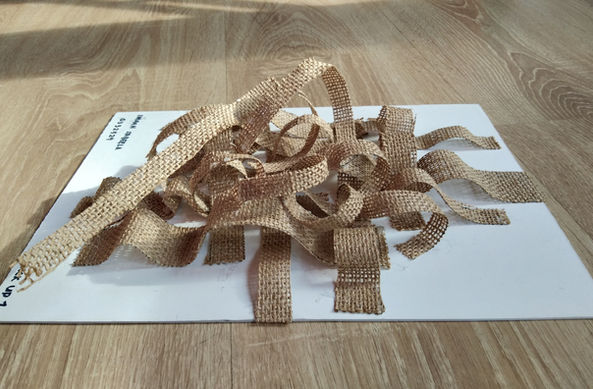PROJECT 1- MADE TO ORDER
For the first project, we were assigned to do an interactive wall display using a specific material that we had to choose from. The goal is for the consumer to experience the beauty of the material chosen. As for mine, I chose to work with burlap/ jute fabric. By doing so, we would have to understand and experiment with the materials' characteristics to be able to give it a new life form. Its functionality towards users also has to be considered, together with the creativity that is put into the final design.
task 01

We had to choose 1 local coffee or tea, and 1 local dessert. As for mine, initially, I chose Masala Tea paired with kuih sago. I figured it would be a good combination because of the creamy and a little spice kick for the tea can be cooled down with the light taste of kuih sago.
For the material, I chose Jute because I wanted it to have a similar connection with the tea and dessert; traditional.

We had to do research on art installations and architecture, wall displays of our materials. There were many artists who use jute, or in general, textile, for their artworks, compared to architects who incorporate textile in their works. Most of the architects don't focus on textile as their main material, instead, the textile only acts as the highlight of a building.


I then broke it down, why Masala tea and kuih sago could be a good combination, but I was told to change my dessert to kuih cara berlauk, because of the similarities in the ingredients for; spices. So my main idea for this project was spices.
MOCK UP 1
For the first mock-up, it was solely for me to experiment and explore on this materials' characteristic. After doing my exploration, I've figured that burlap is not just a material done for sacks, whereas it can be flowy if it's added with glue and water, it is moldable.
MOCK UP 2
For the second mock-up, I wanted to incorporate the keyword "traditional" by adding the woven burlap on the vertical part of the model board. Then, continuing the strips to show the flowy-ness of the material and shaping it into a cave-like tunnel, with the size increasing as it goes to the back. The idea behind this is for the users to walk through and experience the shadow created by the textile itself. It gives different length and depth when it's hit with sunlight from different angles. During this time, my dessert was still kuih sago, which is why the design of the flowy part is inspired by rose petals.


FINAL MODEL 1
During this time, I had to change my dessert to kuih cara berlauk, hence the void shape of star anise's petals. I was not satisfied with this model, because it didn't really show any specialty of this material. I only used it as it is, and didn't apply any of the findings in the mockups to this model.
FINAL MODEL 2
We were given the chance to redo our models, so I redid mine and came up with this idea with the help of Sir Romzi. I understood more about this project after redoing it, because now, I managed to incorporate the characteristics of the textile into the model, and link it with my main idea, which is spices. The structures are a derivation of the star anise's petals and stem, and the flowy-ness of burlap is shown in the middle part of the model.
LAWANG PAZ
























